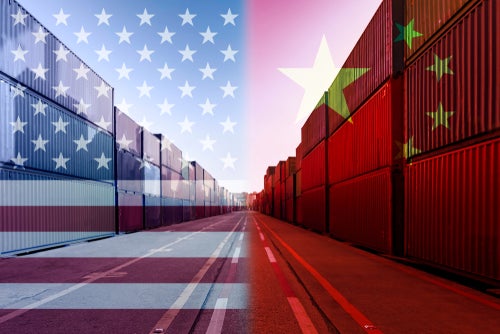It has been over four years since former President Donald Trump started the trade war with China, implementing tariffs and policies that President Joe Biden has kept in place since he took office. It was apparent from the start that the trade war was an ineffective fiscal policy, and the negative economic fallout was predicted from day one. As the data has continued to accumulate, however, it has become clear that the China tariffs are particularly harmful to American families, not China.
Why has Central America not benefitted from China tariffs?
Some suggest that higher tariffs on China have resulted in economic benefits for smaller countries who have seen increased imports and exports as a result of the US and China turning away from each other; however, Central America has not been a beneficiary of this. In many cases, companies who were previously concentrating a large share of their imports and exports through the US or Chinese economies have shifted production to Vietnam or other countries in Southeast Asia, with Vietnam’s quarterly exports to the US nearly doubling in the first two years of the trade war.
This chart, produced by Dr Sheng Lu, a trade expert from the University of Delaware, shows the quantity of US apparel imports through the Dominican-Republic Central America Free Trade Agreement (CAFTA-DR) has been on a consistent decline for almost two decades, and imports through CAFTA-DR remain far below imports from China. Simply put, higher tariffs on China have not encouraged companies to move operations to Central America.
The lack of availability of fibres, yarns and fibres in CAFTA-DR countries
The true reason nearshoring efforts have not been successful and CAFTA-DR utilisation rates are so low is the lack of availability (or short supply) of critical goods such as fibres, yarns, and fabrics in CAFTA-DR countries.
Fortunately, CAFTA-DR provides a mechanism for such goods to be sourced from outside of the free trade agreement without losing its duty-free benefits. However, there are three key issues that need to be addressed before companies can take full advantage of its benefits, problems that have prevented companies from moving operations to Central America despite the trade war.
The first problem is short supply, and CAFTA-DR’s duty-free mechanism needs to be widened to allow greater flexibility and efficiency for apparel producers and other companies to increase their supply. The second problem is the lack of cumulation between CAFTA-DR and other existing free trade agreements, such as the US-Mexico-Canada Agreement (USMCA). All US trade agreements should be linked together to create a system in which US trading partners can operate and receive duty-free benefits. Finally, regional trade will only reach its full potential if nontariff barriers are also reduced, and import and export processes are harmonised in Central America.

US Tariffs are shifting - will you react or anticipate?
Don’t let policy changes catch you off guard. Stay proactive with real-time data and expert analysis.
By GlobalDataFurthermore, while the problem of mass migration from Central America has been well documented, allowing full CAFTA-DR utilisation would address an economic crisis as well as a humanitarian one. Using CAFTA-DR to strengthen trade in Central America strikes directly at the core of the problem – as a robust economy provides stability and decreases the rate of migration.
Not only has CAFTA-DR been underutilised as imports from Asia continue to rise, but as shown in another chart from Lu, both the value and quantity of US apparel imports from CAFTA-DR, taken as a percentage of all US apparel imports, have decreased at a consistent rate for well over a decade. It is not a coincidence that the value of imported apparel goods has decreased consistently as CAFTA-DR utilisation has declined.
CAFTA-DR’s free trade provisions are designed to bring supply chains closer to home by eliminating most tariffs and trade barriers on products and services passing between Costa Rica, the Dominican Republic, El Salvador, Guatemala, Honduras, Nicaragua, and the United States. Problems with its short supply mechanism and other factors, however, mean that not only has the trade war with China harmed American families and businesses throughout the world, but it has done nothing to encourage companies to source from CAFTA-DR countries and seize its unparalleled benefits.
It is incumbent upon President Biden, Vice President Kamala Harris, United States Trade Ambassador Katherine Tai, and Congress to take the three key steps outlined above to strengthen CAFTA-DR. These suggestions will use CAFTA-DR to its fullest effect, ensuring that supply and demand are in unison. Without that, the trade war will continue to cause problems not only for the US economy, but those of our closest trading partners as well.
About the author: Beth Hughes is vice president, trade and customs policy at the American Apparel & Footwear Association, where she oversees AAFA’s Trade Policy Committee and AAFA’s Customs Group. She is also chief spokesperson for the Coalition for Economic Partnership in the Americas (CEPA) launched in November 2021. Before joining AAFA, Hughes served for six years as senior director, international affairs at the International Dairy Foods Association.




